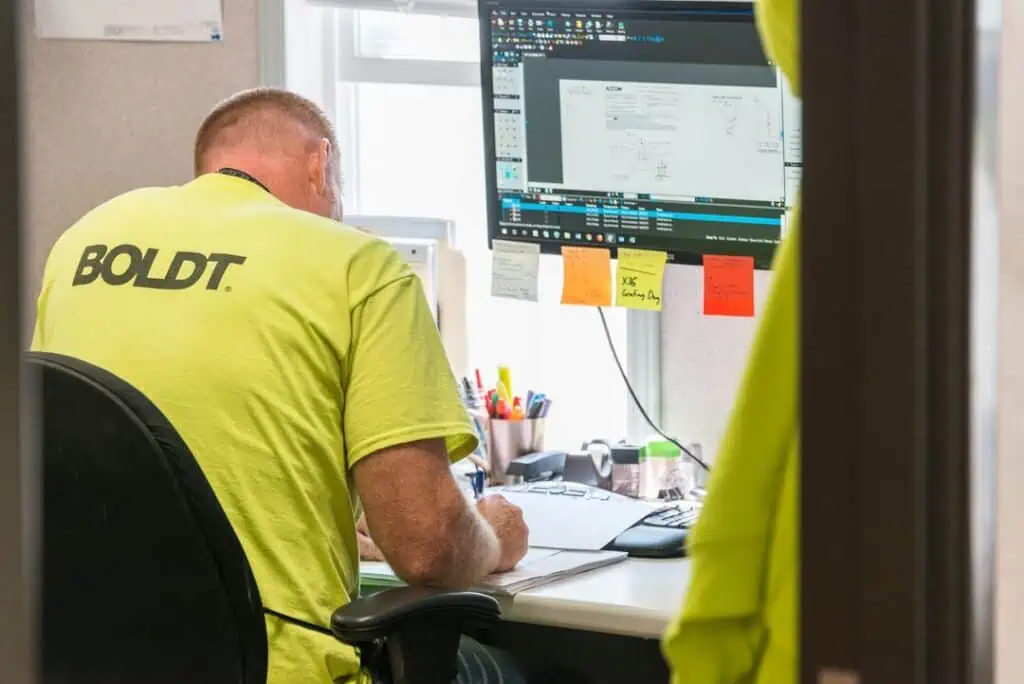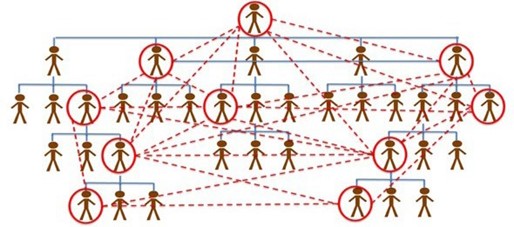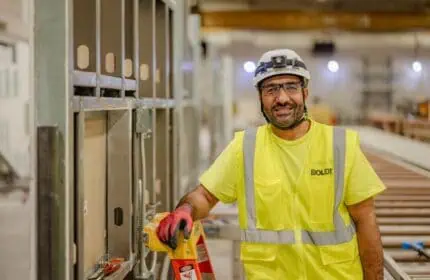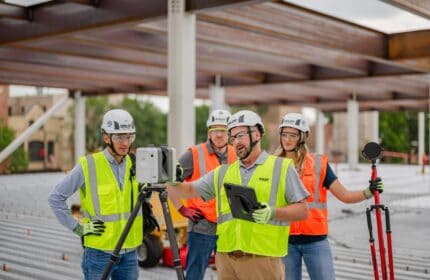Blog
Using Lean Thinking to Accelerate Decision-Making

The hallmark of construction at The Boldt Company is collaboration. But when physical distancing puts a wrench in the personalized give-and-take of building complicated structures, adaptation is critical. Reopening plans for Boldt’s 14 national offices and dozens of job sites depended on rapid innovation and the creative use of technology with the help of lean thinking.
The company created a Covid-19 task force and then tapped experts in its own technical services division to pull together a center of excellence to address reopening. “We quickly accessed the best thinking in the industry to address all the issues surrounding reopening,” said Will Lichtig, Boldt’s executive vice president, performance & innovation.
Lichtig combined a Lean daily management system with the strategies outlined in One Mission, co-authored by Chris Fussell, former Chief of Staff to General Stanley McChrystal, to create a model that combined the agility of a small team with the power of a large organization. To manage the rapid changes posed by the pandemic, Boldt’s leadership realized a hierarchical structure was not nimble enough to address the crisis. “We needed a structure that could deal with a cycle time that was faster than a hierarchical decision tree,” said Lichtig.
The Living Network

A Traditional Hierarchy

By flattening the decision tree, Boldt was able to pivot quickly to keep essential job sites functioning and keep support people safer at home. (Graphics courtesy of the Boldt Company.)
Lichtig was charged with establishing a framework that would provide rapid decision-making, disseminate information quickly, and benefit from the knowledge of a broad base of people. Boldt established a Covid-19 core group, then created a task force that touched every part of the company. Experts in Lean processes who usually put their skills to work for construction customers redirected their efforts into the organization.
Navigating the rapidly changing environment was possible because Boldt has been a Lean organization for years. The firm is one of the top construction services providers in the nation with a reputation built on an Integrated Lean Project Delivery model (ILPD). The process combines the efficiency of Lean processes with Integrated Project Delivery in a highly collaborative environment to provide the most value for customers. The ILPD model has been successfully used on complex, multi-million- dollar healthcare projects and was now being focused internally on the Boldt organization. Projects using ILPD¨ have included an ambulatory surgery & critical care tower for Akron Children’s Hospital and the $2.1-billion hospital for Sutter Health located in the heart of urban San Francisco.
Lichtig tapped the skill sets of seasoned Lean practitioners within the organization. Jason Schulist was one of those experts with a long career in applying Lean processes and continuous improvement in private businesses and social enterprises. His mission was to create a teaming environment and make the most agile, adaptable problem-solving process possible.
“Typically, that isn’t the way Lean works here,” Schulist said. “Typically, we run one PDSA [plan-do-study-act] cycle, learn from it, and do another, but in the Covid-19 world, we had to do multiple, concurrent experiments so we could make a decision and adapt quickly.” Schulist and the team created a model that stressed sharing information through a living network. Information from daily videoconference meetings was reported to the executive level team that committed to making decisions by 3 p.m. that same day. In some instances, as many as 45 people participated in Microsoft Teams conference calls–many convened daily at the beginning of the pandemic.
The task force identified problem areas in operations, safety, technology, and different geographic markets, and assigned a leader for each topic. Team members noted issues such as split work schedules, employees who would continue to work from home, different state requirements, and even their teams’ mood. Each regional office was asked to develop and implement a range of best practices to support these goals in areas that touched on parking, building entrances/exits, office layout, plumbing, HVAC, health assessments, and more. “We were clear with our teams to establish ground rules, to define limits of authority, and to enable them to execute without checking back with headquarters,” Lichtig said.
Holly Lifke was a vital member of the team as Boldt’s executive vice president of human resources. She was first introduced to Lean thinking processes in manufacturing, then later in the insurance industry, but realized that even a reliable Lean process was not going to work without guidelines.
“Our guiding principles were the health of the individual and the health of the organization,” Lifke said. That gave us the ability to create solutions for each location, and instead of having each office rebuild the wheel, we gave them the wheel.” To make a complicated situation more complex, guidelines needed to be established for craft workers at job sites in states with varying rules for reopening. Additionally, Boldt teams worked closely with project owners, many of whom were in essential industries such as healthcare.
From a people perspective, Lifke credits the process with giving team members an anchor. “It created a structure that helped us ensure a consistent deliverable to our employees, craft employees, and customers. It provided a semblance of logic in an illogical time.”
Using IT to Drive Implementation
Information technology was a tool that helped implement the Lean strategic plan. Boldt was on a Microsoft Teams platform that made it seamless for much of the workforce to work from home without losing connectivity. According to the firms’ IT department, within 90 days, Boldt employees nationwide engaged in:
- 335,224 chat messages,
- 15,517 video or telephone meetings,
- 17,197 participants in those meetings.
On construction job sites, there were even more unique challenges. In most states, construction had been declared an essential industry, so early in the pandemic, Boldt created a health screening system for anyone entering a job site or office. Workers, subcontractors, and even customers were required to fill out a daily health assessment form and have their temperature screened. But the individual pieces of paper started piling up, and the number of subcontractors on multiple job sites compounded the problem.
Dan Wagner, a Boldt superintendent in California, was juggling 150 pieces of paper a day and trying to do it while working remotely. “A paper form requires someone to touch it, put it in a bin, and keep as a record,” Wagner said. “The very nature of the process was counter to achieving a seamless process that doesn’t spread the virus.”
That’s when Wagner got on the daily videoconference and asked if the Boldt IT group could design a process based on smartphones. Using Microsoft Forms, Boldt IT created a process in which anyone entering a job site scans a QR code that immediately directs them to an online health assessment survey. If an individual’s answers raise a potential Covid-19 concern, the screen indicates the user is denied job-site access, and the survey is immediately referred to the superintendent and a safety manager.
“The system notifies us in seconds,” Wagner said. “It makes our safety managers’ lives so much easier because they can manage information and get the reports while working remotely.” He added that most people who don’t pass the assessment do so because they made a data-entry error. Thanks to the processes that were already in place, this innovation was discussed on a Monday, was in testing the following Friday, and was rolled out to California job sites in two weeks.
By flattening the decision tree, Boldt was able to pivot quickly to keep essential job sites functioning and keep support people safer at home. When reopening discussions started, the framework was in place to move rapidly and maintain consistent goals: keep the coronavirus out of offices and job sites, prevent the spread of the virus, and keep all locations clean.
This adaptive Lean approach to pandemic planning and reopening has helped the organization in three primary areas. “For our immediate needs, it has helped us bring people back into the office, especially those who want to or need to be in an office setting,” Lichtig said. “In the next 3 to 6 months, it will address how we will sustain our approach, and beyond that, it will help us determine what the office of the future will look like,” Lichtig said.
This copyrighted article was originally published in The Lean Post, the blog of the nonprofit Lean Enterprise Institute. It is republished with permission.”
About The Boldt Company
The Boldt Company (Boldt) is a leading professional construction services firm with customers across the United States and is a subsidiary of The Boldt Group. Founded in 1889, Boldt is a fourth-generation family and employee-owned firm headquartered in Appleton, Wisconsin. Boldt is recognized as a pioneer in Lean construction and in the industrialized construction space. Boldt operates 18 offices across the U.S. that serve customers in healthcare, power, industrial, education, automotive and commercial markets.


